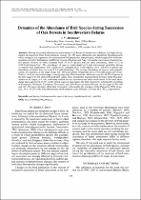Показать сокращенную информацию
Dynamics of the Abundance of Bird Species during Succession of Oak Forests in Southwestern Belarus
| dc.contributor.advisor | Английский | |
| dc.contributor.author | Abramova, Iryna | |
| dc.date.accessioned | 2023-12-11T07:11:41Z | |
| dc.date.available | 2023-12-11T07:11:41Z | |
| dc.date.issued | 2023 | |
| dc.identifier.citation | Abramova, I.V. Dynamics of the Abundance of Bird Species during Succession of Oak Forests in Southwestern Belarus / I.V. Abramova // Biology Bulletin, 2023. – Vol. 50. – No. 8. – pp. 144–154. https://rdcu.be/dtyyN | ru_RU |
| dc.identifier.issn | 1062-3590 | |
| dc.identifier.uri | http://rep.brsu.by:80/handle/123456789/9463 | |
| dc.description.abstract | During the period of secondary succession of oak forests in southwestern Belarus, six stages of vegetation development (from fresh cutting to mature 120-150 years old forest) were identified. Simultaneously with a change in the vegetation, the succession of bird population also proceeds, which is typical for bird communities and other formations in different regions of Europe and Asia. During the succession of oak forests, the species richness of birds increases from 10 to 58 species and the total abundance, from 153.2 to 1128.9 individuals/km2. The abundance of species (individuals/km2) and interannual variability during 11 seasons were established. The coefficient of variation (CV) is the highest (50.0-116.0%) in species the abundance of which does not exceed 5.0 individuals/km2. The average abundance of species varies significantly, for example, at the stage of age 120-150 years (from 1.0 (goshawk) to 275.0 individuals/km2 (chaffinch)). In all six succession stages, nesting migratory birds dominate, which account for 80.0% of species at the first stage to 53.4% at the fifth and sixth stages. Near and distant migrants form the basis of the bird population at all stages; as a rule, sedentary species are not numerous and their involvement in the total abundance does not exceed 17.3%. At the initial stages of succession, the bird community is formed by members of European, Palearctic, European-Turkestan, and Afro-Eurasian types of fauna. At the stages of 80-100 and 120-150 years, the basis of the bird community is formed by the members of the Palearctic (50% of species, 34.5-35.2% of the total abundance) and European types of fauna (22.4 and 48.0-49.3, respectively). | ru_RU |
| dc.language.iso | en | ru_RU |
| dc.publisher | Biology Bulletin | ru_RU |
| dc.relation.ispartofseries | ;8 | |
| dc.subject | oak forests | ru_RU |
| dc.subject | bird community | ru_RU |
| dc.subject | species richness | ru_RU |
| dc.subject | population density | ru_RU |
| dc.subject | stability | ru_RU |
| dc.title | Dynamics of the Abundance of Bird Species during Succession of Oak Forests in Southwestern Belarus | ru_RU |
| dc.type | Article | ru_RU |
